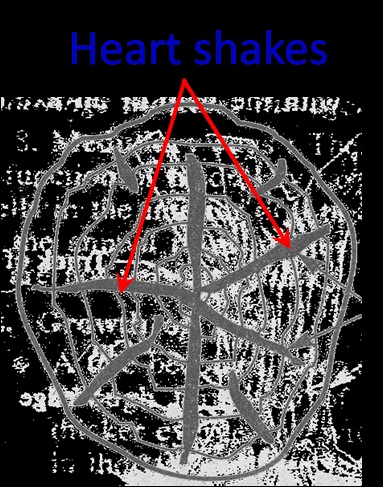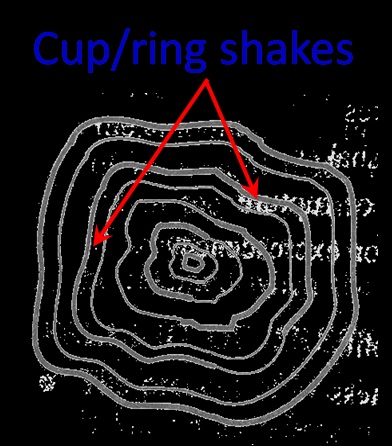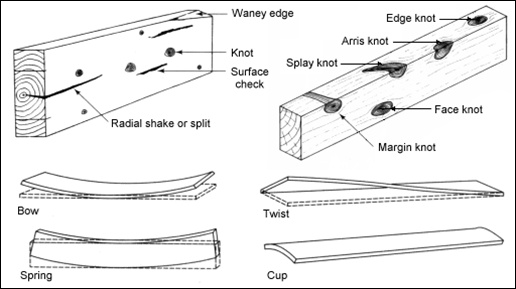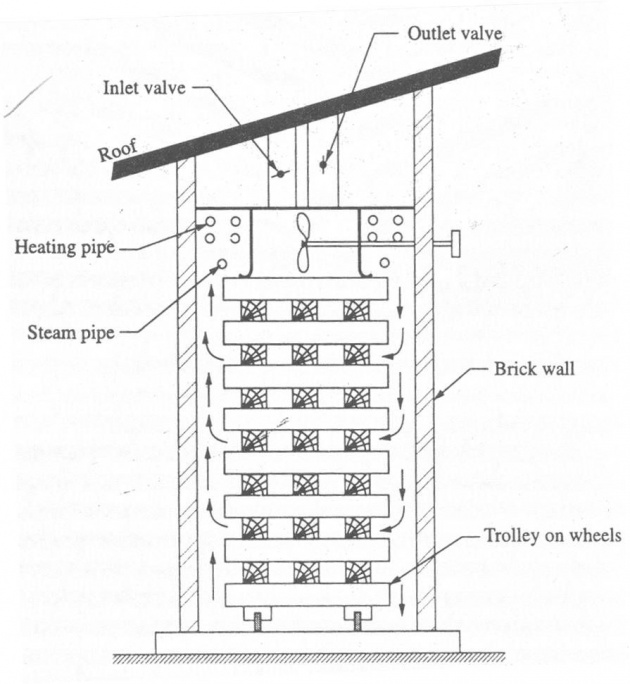Timber is one of the oldest building materials known.
It has been used in buildings in most parts of the world for thousands of years.
In low energy ages, timber was the natural material of choice
Timber is a light construction material with a high strength to weight ratio.
Standing timber: part of a living tree
Rough timber: part of a felled tree
Converted timber: sawn to various forms like beams, battens and planks, etc.
Dressed timber: sawn timber which has been placed and worked to the required condition.
Clear timber: timber free from defects.
Classification of trees
Endogenous: Grows inwards.
Grow in longitudinal fibrous mass like palm, cane, bamboo, banana, etc. Except bamboo unsuitable for engineering purpose.
Exogenous: Grow outwards.
Conifers: Evergreen trees yielding soft wood. Deodar, chir, fir, kail, etc. Distinct annual rings, straight fibers, light color, resinous and light weight.
Deciduous: Flat broad leaf trees yielding hard wood. Oak, teak, shishum, poplar and maple. Indistinct annual rings, non-resinous, dark in color and heavy weight
Structure of tree
Pith or Medula: innermost portion or core of tree.
Heart wood: inner annual rings surrounding pith.
Sap wood: outer annual rings that transmit sap from root to branches.
Cambium: thin layer below bark, not converted to sap wood not as yet.
Bark (outer & inner): outermost protective layer of cells and woody fibers that splits and peels off. It is the skin of the stem.
Annual rings: these consist of cellular tissues and woody fiber arranged in distinct circles or rings around the pith generally one in every year.
Medullary rays: thin horizontal veins from bark to pith to carry sap inwards. Only few are visible to naked eye and they hold the annual rings together.
Tree growth
Spring season
Salt and water solution sucked by the roots
Under sunlight absorbs CO2 from air
Viscous solution is called sap
Autumn season
Sap descends under the bark and leaves a thick layer
Sap layer transformed into wood as cambium layer
New layer added each year as annual ring
Sap carried through medullary rays from bark to interior
New wood on outside of tree
oldest wood on the inside
youngest wood on the outside
diameter largest at the base
one ring (layer) per growing season
Tree in forest grows toward light
trunk is straight
lower branches die
leaving small knots in wood
Bark protects wood from damage
the tree sheds bark each year
Characteristics of good timber
Obtained from heartwood area of tree and free from sap
Should have straight and close fibers
Dark uniform color with uniform texture
When struck, sonorous (loud & deep) ringing sound is produced
Narrow annular rings, closer the rings greater is the strength
Compact medullary rays
Sweet smell and a shining fresh cut surface
No clogging of saw teeth during sawing
Free from the defects like dead knots, shakes etc
Heavy weight
Bright and smooth surface when planed
Defects in timber – during growth
Shakes: separations between annual rings
Heart shake: radial splits in heartwood due to shrinkage

Star Shake: radial splits or cracks wider on surface and narrow inwards, due to severe heat and frost action
Cup shake: curved split among annual rings. Also called ring shake


Radial shake: similar to star shakes but are finer, irregular and numerous
Upsets: crushing of transverse fibers due to winds
Twisted fibers: wind turning the trunk and twisting fibers
Rind galls: growth of sapwood layer over wounds
Defects in timber - knots

Knots: root of small branches buried in mother branch annual rings. This modifies the tissues in elliptical or concentric circles . Knot disturbs the homogeneity , strength and workability of wood.
Dead or loose knot: separable
Live or sound knot: inseparable
Size based classification
Pin knot: under 12 mm
Small knot: 12 to 20 mm
Medium knot: 20 to 40 mm
Large knot: over 40 mm
Form based classification
Round knot
Spike knot
Quality based classification
Sound knot: hard and solid as surrounding wood
Decayed knot: contains advance decay, softer than surrounding wood
Encased knot: annual rings fail to grow into fibers of surrounding wood
Tight knot: a knot so securely fastened that it holds its position in finished product
Occurrence based classification
Single knot: wood fibers deflect around one knot
Cluster knot: wood fibers deflect around two or more knots as one unit
Branch knot: two or more knots radiating from one common center
Defects in timber – diseases and decay
Diseases
Dry rot: fungus turns timber to dry powder
Wet rot: decay due to alternate wetting and drying
Decay
Decay due to fungal and bacterial attack
Damage due to insects
Termites, white ants
Beetles: powder post beetles, long horn beetles, ambrosia beetle,
Carpenter ants
Damage due to rodents (mice, rats, squirrels, etc.)
Seasoning of timber
Seasoning: extraction of moist sap under controlled conditions (as nearly as possible at a uniform rate) from all parts of timber, and to leave inextricable moisture uniformly distributed throughout
Irregular drying causes irregular shrinkage leading to warping and shakes formation
Objectives:
To reduce the shrinkage and warping after placement in structure.
To increase strength, durability, and workability.
To reduce its tendency to split and decay.
To make the timber suitable for painting.
To reduce the weight of timber.
Air or natural seasoning: timber stacked in ventilated shady place. Slow process takes six months to two years
Kiln or artificial seasoning: steam chamber with controllable temperature and humidity. Rapid 4-5 days.
Natural seasoning – air drying
Advantages
Not much attention needed
Simple and cheap method
Less chances of damage to timber
Disadvantages
Very slow process
Considerable space is required
Difficult to get desirable moisture content
Chances of attack by fungi and insects
Benefits of drying
Drying timber increases its:
strength;
stiffness;
stability
durability; &
ease of fastening.
Natural seasoning – water seasoning
Logs of wood are completely immersed in a running stream of water.
Longer ends of logs are kept pointing up-stream.
Sap, sugar and gum etc. are leached out of the wood and replaced by water.
Disadvantage: the process reduces the elasticity and durability of the timber. The timber becomes brittle.
Artificial seasoning
It is quick method, and moisture content can be kept under control (4-12% depending upon conditions).
For dry region the water content may be 4-6 %.
For humid regions the water content may be around 10%.
The most common method of artificial seasoning is kiln seasoning method.
Electrical seasoning:
The logs are placed in such a way that their two ends touch the electrodes. Current is passed , wood resists the flow of current. During this process, heat is generated which results in drying of timber.
Timber preservation
Preservation is protection of timber from attack of insects and internal decay.
Perfect seasoning is the best form of timber preservation.
Methods of preservation
Tarring
Charring
Painting
Creosoting
Ascue treatment
Fire proofing
Tarring: A coat of tar or tar mixed with pitch is applied. Used for rough types of work, such as timber fences, ends of door and window frames (built into the walls).
Charring: to prevent dry rot and insect attacks, the lower ends of posts to be embedded in ground are charred. The posts are charred to depth of 1.5 cm over a wood fire and then quenched in water.
Painting: carried out on the thoroughly seasoned wood other wise paint may confine sap and cause the decay.
Creosoting:
Creosote oil is most widely used preservative treatment where dark color and odour do not make product too objectionable.
It is applied under pressure of 9 bars and at a temp of 50oC.
Creosoting preserves timber from rot and insect attacks.
It is usually employed for piles, poles and railway sleepers.
Ascue treatment: Ascue is in powder form. A solution is prepared by dissolving 6 parts of powder in 100 parts by weight of water. The solution is sprayed on the timber.
Fire proofing: timber made fire resistance by soaking in NH4SO4, NH3Cl, NH4PO3, NaAs, ZnCl.
Preservatives
Oil type preservatives: applied over outside of exposed timber, give un-pleasant smell, timber can not be painted. e.g. cerosote, solignum, carbolinium.
Water soluble preservatives: are odorless organic or inorganic salts as zinc chloride, boric acid etc. These are applied to timber used inside locations only. Preservative used in water 6 part of powder and 100 parts by weight of water.
Solvent treatment: Consist of toxic chemical compounds as pentachlorophenole, bezene-hexa-chloride, dichlorodiphenyl trichloro-ethane (D.D.T) and copper naphathenate. These are dissolved in kerosene, sprit etc.
Acetic anhydride treatment: It is used for veneers, plywood and light lumbers protection against decay by acetylation. They are treated with acetic anhydride vapor, which minimizes swelling and improves resistance to decay and attack by insects.



